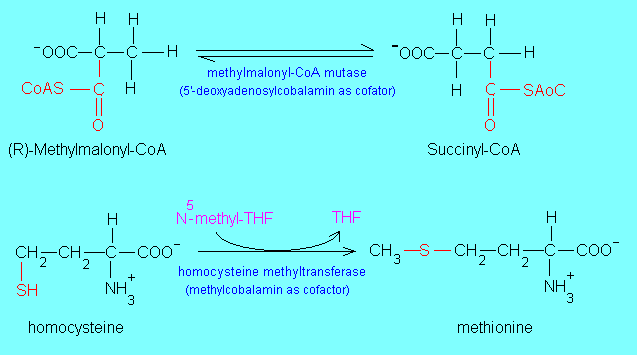|
Vitamin B12 (Cobalamin)
Vitamin B12 has the most complex chemical structure of all vitamins. It exhibits a hemelike corrin ring
system to which cobalt (as Co3+) is coordinated. Its unique feature is that cobalt is
covalently bound to the 5' carbon of the deoxyribose moiety of deoxyadenosine. The C-Co bond is the only
carbon-metal bond known in living systems. This bond is relatively weak for the mere illumination of
cobalamin with visible light leads to the cleavage of the C-Co bond.
Vitamin B12 functions as coenzyme for several enzymes of which only two occur in mammalian
systems: methylmalonyl-CoA mutase (5'-deoxyadenosylcobalamin as cofactor) and homocysteine
methyltransferase (methylcobalamin as cofactor). The former catalyzes the last step in the conversion of
propionyl-CoA to succinyl-CoA (the full path is shown on the Biotin page). The reactions catalyzed by
these two enzymes are shown below:

It is interesting to note that in the reaction catalyzed by methylmalonyl-CoA mutase the
5'-deoxyadenosylcobalamin prosthetic group forms a free radical upon the homolytic
cleavage of the C-Co(III) covalent bond (in most biological cleavage the process occurs
via heterolytic cleavage). As a result Co3+ is reduced to Co2+,
then reoxidized in the later stage of the catalytic process with the re-formation of the C-Co
bond just after the product, succinyl-CoA is released from the enzyme-cobalamin complex.
Some of the processes in which cobalamin is involved are listed below:
- DNA synthesis in body cells. Especially sensitive to vitamin B12 deficiency are the fast
reproducing cells such as those lining the oral cavity, the gastrointestinal, urogenital and
bone marrow.
- Erythropoietic cell development and maturation as well as other blood cells involved in
defence against pathogens.
- Degradation of fatty acids with an odd number of carbon atoms in some marine organisms.
The final round of b-oxidation of these fatty acids yields
propionyl-CoA, which is then converted to succinyl-CoA for entry into the citric acid cycle.
- Amino acid metabolism, i.e. the conversion of homocysteine to methionine.
- Secretion of melatonin in the brain. Low levels of melatonin are associated with sleep-wake
rhythm disorders.
- Essential for adrenal hormone synthesis, promotion of nerve growth and development as well as
mood regulation. Normal B12 levels are associated with feelings of well-being.
- Interactions: Vitamin B12 works with folic acid in
biochemical reactions involving methyl group transfers such as in the synthesis of methionine
from homocysteine. The buildup of homocysteine in blood plasma may be a factor in the
formation of the atherosclerotic plaque. High alcohol and coffee consumption, heavy smoking,
low intakes of calcium and iron and liver disease can cause vitamin B12 deficiency.
- Health benefits: Supplementation is useful in conditions
like asthma, depression, impaired mental function in the elderly, HIV infection. A recent study
showed that 39% of American adults age 26-83 have very low levels of B12 in their blood (1).
- Best food sources: Organ meats (liver, kidney), eggs, fish,
cheese.
References
1. Tucker, K.L. et al. (2000) Am.J.Clin.Nutr. 71(2) 514-522. Plasma vitamin B12 concentrations relate
to intake source in the Framingham Offspring study.

|